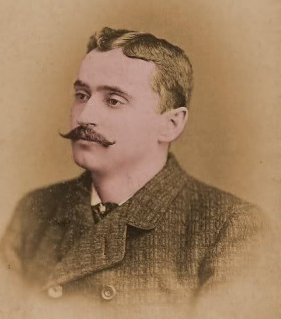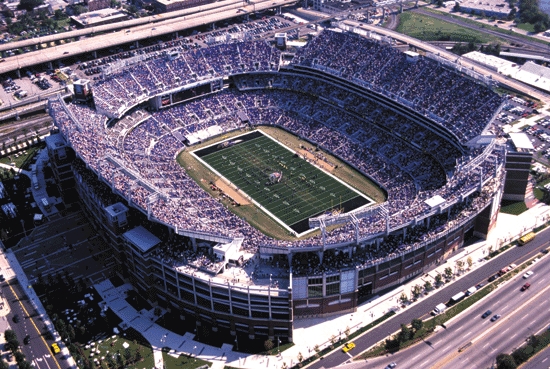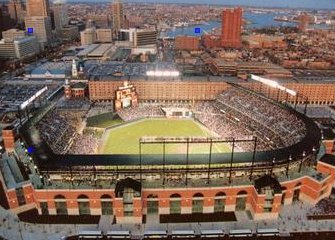 Edward Hugh (Ned) Hanlon | Mount Pleasant ParkGolf CourseMaryland's Tournament CourseEstd. June 30, 1934 | Charles Augustin (Gus) Hook |
 Edward Hugh (Ned) Hanlon | Mount Pleasant ParkGolf CourseMaryland's Tournament CourseEstd. June 30, 1934 | Charles Augustin (Gus) Hook |
Ned Hanlon died on April 14, 1937. Up to his passing at age 79, he remained active on the Park Board. He was appointed in 1916 and served for 21 years, the last six as its president. The day before his death he spent at his office, planning the ceremony to be held dedicating Mount Pleasant's renovated clubhouse and pro shop. History remembers Hanlon only as “The Father of Modern Baseball.” His inventions and refinements are commonplace in today's game, including the most electrifying play of them all; the suicide-squeeze bunt.
Gus Hook worked for the city for over 40 years, with a brief interruption for military service overseas in World War I. He became the director of recreation and parks in 1959, and held that post until his retirement in November, 1964. He died after suffering a heart attack on August 19, 1965, at the age of 67, and is buried [as is Ned Hanlon] in the New Cathedral Cemetery.
In 1951, after the touring professionals had been tested by Mount Pleasant for the first time, Hook was honored for his work with the award of a lifetime membership in the Middle Atlantic Section of the PGA of America. Hook was honored as “Man of the Year” by the Advertising Club of Baltimore in 1959, primarily for his work on Pine Ridge Golf Course. In addition to designing that course, he supervised its construction, and saved the city much money by employing parks department labor and machinery to build it. The Baltimore Chapter of the Benevolent and Protective Order of Elks honored Hook by electing him their Exalted Ruler.
Ned Hanlon and Gus Hook combined to create a splendid golf course. In all accounts, each man is described as honest, sincere, dedicated to any task he undertook, a hard worker willing to go to great length to learn to do anything, stubborn, autocratic, and above all, a gentleman. It does not require a great stretch of the imagination to visualize Ned Hanlon, in testimony before the City Council about the progress of the golf-course construction, wearing a lapel pin that read, “Ask Hook.” Their individual traits of personality and character undoubtedly both clashed and meshed, and resulted in the creation of an urban masterpiece. Mount Pleasant Golf Course is a worthy memorial to these two men.
The course is one of many worthy memorials to the resilience and innate good character of the citizens of this country. It should serve as a tribute to those politicians and bureaucrats whose understanding of human nature, foresight, and statesmanship preserved our democracy during the chaotic social emergency of the Great Depression. It is as well a tribute to the many thousands who labored for $47.17 a month to build Mount Pleasant and other courses under New Deal jobs programs. In the absence of this opportunity for work, they quite easily could have opted to wear brown shirts and black leather coats and march with funny steps, and give vent to their collective despair through the most vicious and vile acts against fellow human beings, as was done in Europe. Instead they built Mount Pleasant Park and three of the five courses at Bethpage State Park [including the Black and the Blue courses] and many other fine public courses around the country. As a race, as much as we refuse to admit it, we need visible reminders that it is better to build than to destroy. The lesson is too easy, and therefore deemed trite. But a glance at today's newspaper shows the lesson hasn't yet been learned.
The course serves as a relevant tribute to the game of golf itself. In this era of technological advances in shaft, clubhead, and ball construction, Mount Pleasant remains as resistant to low scoring as it was in the 1930's, 40's, 50's, and 60's. As discussed in several chapters in this site, the course presented the sternest test for golfers in the 1939 U.S. Amateur Public Links Championship, the Eastern Invitation Opens of 1950 through 1958 and 1962, and the U.S. Open qualifying rounds in 1954 and 1956. The analysis of the scores of the area's best golfers in various events conducted in the last few years demonstrates not only that the course continues to present a very stiff challenge, but also shows that Mount Pleasant, at the very least, compares favorably with other courses built relatively recently in the area that currently host important professional and amateur championships.
Mount Pleasant Golf Course currently plays to a par-71 over 6,756 yards. The published length tends to encourage the belief that the course is short. However, there are only two par-5 holes; No. 1 and No. 10. How much relatively shorter is it than, say, a 7,000-yard course having four par-5's? It is said and written that the long-hitting modern professionals and amateurs of today would bring the course to its knees. This statement is made often. Actual evidence of its truth is non-existent. One can only imagine the difficulty of the course should some visionary renovation architect conceive the idea of putting fairway bunkers on it, or growing the rough to a height that would have some effect on shots from it.
Mount Pleasant, along with Pine Ridge Golf Course, should also serve as reminders of the propositions that vast amounts of money are not necessarily needed to accomplish a task, and that “experts” are not required to perform it. The land for the course was acquired at a cost-per-acre much lower than previously and afterwards acquired city parks. The course was ultimately designed not by an expert, but by a city employee whose innate talent for design was encouraged by another city employee whose own talent lay in the capacity for recognizing and nurturing talent in others. It was designed, and the superintendence achieved, not by expensive contract, but by payment of usual wages to a current employee, one whose talent for supervision was also realized. The clubhouse and pro shop were housed in the renovated structure of an existing building, resulting in substantial savings to the municipality. When drought threatened play of the 1939 U.S. Amateur Public Links Championship, the emergency was again handled by a city employee who saved the event by fostering cooperation among city agencies and with the use of surplus municipal equipment. Pine Ridge Golf Course serves as an even greater example. It was designed in-house, and built entirely by city employees using municipal equipment under the supervision of a municipal employee. The cost of its construction was paid, in its entirety, by the profits from tournaments held at Mount Pleasant.
In these modern times, almost all new golf courses are built in rural areas. They are constructed at huge expense, with the result that their greens fees must be set at a cost greater than the average yearly income of a citizen of the Third World. The inner cities of this country are rotting, block by block and neighborhood by neighborhood. As $100,000,000 each day leaves our national borders in drug profits, the visible result is seen in the form of boarded-up vacant houses, burned buildings, and graffiti-covered walls. Only because we [currently] have sufficient land to continue development farther from our cities into outlying virgin property can we turn blind eyes to the cancers that are expanding in downtown areas. Rather than defend our existing monuments and treasures, we retreat and try to build new ones. We have become a nation of 'instant tradition,' not because we are provincial ignoramuses, but out of a shortsighted belief that to do so is a necessity.
There are a few instances where folks didn't run away. Consider the East Lake Golf Club in Atlanta. In 1898, the Atlanta Athletic Club was formed. Architect Tom Bendelow was retained to design the club's golf course. Bobby Jones was present when the course was opened in 1908. He later served on the club's board for 38 years, and as president in 1946 and 1947. In 1913, Donald Ross redesigned the course. The club hosted important golf tournaments over the years, including the Women's National Golf Tournament and the Ryder Cup matches of 1963. Soon after the Ryder Cup was played, the membership of the Atlanta Athletic Club fled the inner city course and built a new one in the suburbs. The area around East Lake continued its decline, and became an area infested with drugs and urban decay.
In 1993, a foundation concerned with the problems of the inner city of Atlanta purchased the East Lake Golf Club. Individual and corporate tax-deductible [hint, hint!] contributions were used to restore the course. Architect Rees Jones supervised the duplication of Donald Ross' original course design. The clubhouse was restored using the 1926 drawings of the original architect. The theme of the project is a memorial to the life and accomplishments of Bobby Jones. The club now serves as the centerpiece of the foundation's efforts to revitalize the communities surrounding the course, and the efforts are, by all accounts, hugely successful.
 M & T Bank Stadium cost $228 million in 1998. In addition to hosting Ravens games, the stadium serves as the city's cultural center for fine arts,
hosting artists such as the Foo Fighters, Red Hot Chili Peppers, Offspring, Blink-182, Billy Idol, and the Goo Goo Dolls. In 2011, Monster Jam became an annual event for the venue.
M & T Bank Stadium cost $228 million in 1998. In addition to hosting Ravens games, the stadium serves as the city's cultural center for fine arts,
hosting artists such as the Foo Fighters, Red Hot Chili Peppers, Offspring, Blink-182, Billy Idol, and the Goo Goo Dolls. In 2011, Monster Jam became an annual event for the venue.
Mount Pleasant Golf Course is recognized as Maryland's “Tournament Course.” This characterization is derived from its history as host of the USGA's Amateur Public Links Championship in 1939 and of the PGA of America's Eastern Invitation Opens from 1950 to 1958 and again in 1962. The current roster of championships played there annually continues the tradition of high-level competitions: the Baltimore Women's Amateur Championship, the Baltimore Two-Man Team Championship, and the Maryland Amateur Stroke Play Championship. Additionally, each year Mount Pleasant hosts either the first or the last day's matches of the Challenge Cup, pitting the team composed of club champions of Baltimore-area private clubs against the team made up of the 12 golfers earning the highest point-totals alloted in BMGC-sponsored public events for the year. The course is an extraordinarily valuable asset to the city of Baltimore and the state of Maryland, and deserves the official attention, care, and support given to other major sports venues. Perhaps it merits more in this tax-happy democracy of ours, because, after all, how much easier is it to book a tee time at the Mount than to schedule a touch football game with friends at M & T Bank Stadium, or a pickup softball game at Oriole Park at Camden Yards?
 Oriole Park at Camden Yards cost $110 million to build in 1992. Because the Birds haven't done well since the stadium was built,
it has been used primarily as a backdrop for Hollywood movie and TV scenes in which an actor playing the president throws the first pitch
(Kevin Kline in Dave; Chris Rock in Head of State; Geena Davis in Commander in Chief; and Martin Sheen in The West Wing).
Oriole Park at Camden Yards cost $110 million to build in 1992. Because the Birds haven't done well since the stadium was built,
it has been used primarily as a backdrop for Hollywood movie and TV scenes in which an actor playing the president throws the first pitch
(Kevin Kline in Dave; Chris Rock in Head of State; Geena Davis in Commander in Chief; and Martin Sheen in The West Wing).